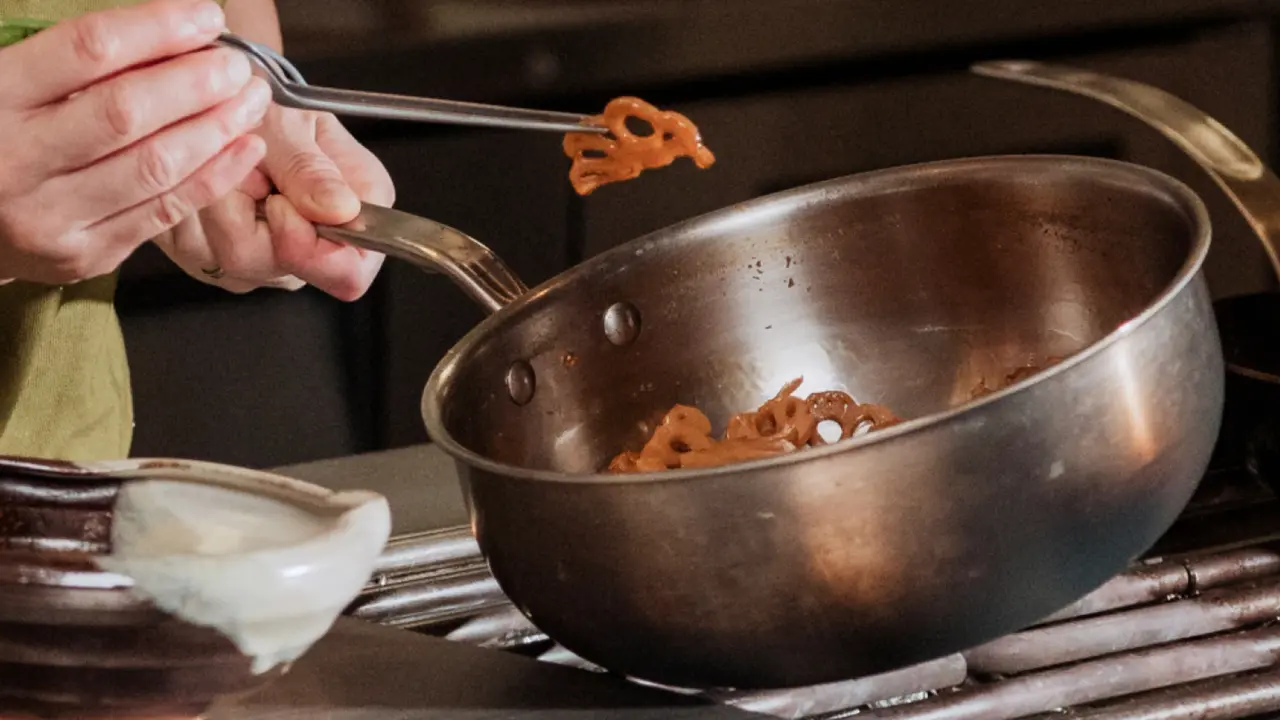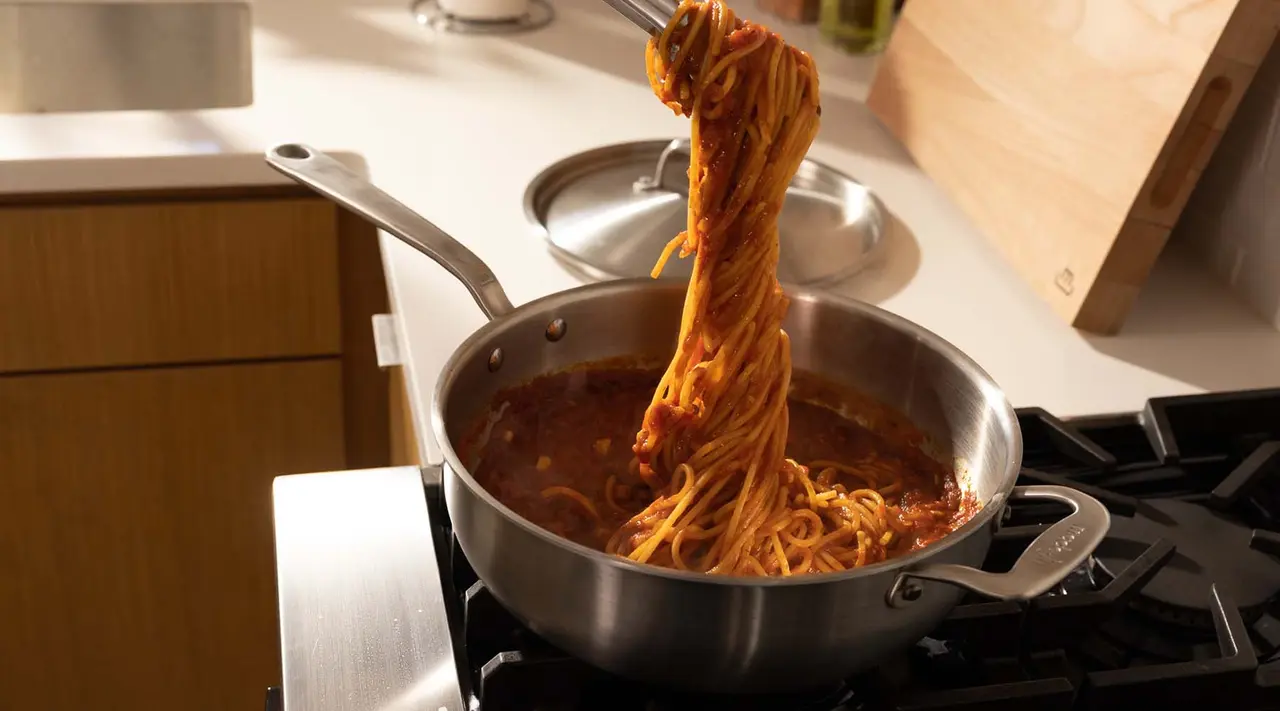If you’ve seen a saucier pan, you may have wondered what this large, rounded saucepan is and how, aside from a fancy name, it’s any different from the pans you already have in your kitchen. The defining trait of a saucier is its telltale rounded, curved bottom that gently curves upward, rendering the bottom of the pot cornerless. (Compare this with the perpendicular edges of a saucepan.)
Sauciers are the ideal vessel in which to whisk sauces, cook jams, and stir grits. Keep reading to learn why the chef-loved tool belongs in professional and home kitchens alike.
Understanding the Saucier

Sauciers come in a range of sizes, typically from 2 to 5 QT. In addition to its signature curved bottom, a saucier features relatively short sides and an ample cooking surface. All of these traits prove especially useful when whisking and making sauces—the curved sides prevent clumping and scorching, and there are no corners for ingredients to get squished into. Shorter sides provide easier access for whisking, and the extra surface allows sauces, broths, and stocks to reduce more quickly.
Another bonus: we designed our sauciers with a curved lip, so if you have to pour any sauces or liquids, you can do so without annoying spills and drips down the side of the pot.
Compared to a saucepan—another super versatile piece of cookware—a saucier boasts more surface area, shorter sides, and a rounded bottom. Sauciers are ideal when you want to reduce liquids quickly, or when you need to stir frequently to encourage even cooking and prevent scorching (like with a risotto, for example). Saucepans, on the other hand, are excellent when cooking soups and other brothy things, since their high sides help prevent liquids from bubbling over.
Benefits of a Saucier
Sauces are where a saucier shines, but the shape is also conducive to making all sorts of tasty treats. Since our sauciers—like all our Stainless Clad Cookware—are made with premium 5-ply construction, you’ll get maximum heat conduction, distribution, and control.
Wide surface area and short sides mean it’s easy to stir things like grits and mac and cheese. You can go sweet in a saucier, too: jams and fruit preserves reduce quickly without scorching, and caramel sauce or chocolate ganache come together in a snap.
And when it’s time to make a big batch of sauce—a classic red sauce for a pile of spaghetti, for example—your saucier is the ideal tool for simmering and coating every strand of pasta. All you need to cue up for spaghetti perfection are a glass of wine and your favorite Sopranos episode.
Why Every Home Cook Needs a Saucier

If you already have a saucepan, you may wonder if you really need a saucier. (Or perhaps you’re choosing between the two—a tough decision!) Here from team saucier’s side are a few reasons to go with a saucier:
- Cheffy feel. While you shouldn’t make all your decisions based on what chefs do, when it comes to cookware, a saucier is restaurant professional-approved for its versatility, control, and function.
- One-pot meals. Lots of surface area, shallow sides, and a well-fitting lid mean you can sear proteins, make a pan sauce, and cook a carb—all in the same pot. Dinner time stress, who?
- Learning techniques. If you’ve ever wanted to master the French mother sauces, or learn to make sauces from a variety of cuisines, a saucier is your tool.
- Good investment. Our saucier features premium 5-ply construction. With proper care and cleaning, your saucier can last a lifetime. That’s a whole lifetime of exploring all the ways to make pasta and sauce.
How to Choose the Right Saucier
Sauciers come in different sizes, materials, and price points. Below we offer guidance on choosing between them.
Size and Capacity Considerations:
As mentioned above, sauciers typically range in sizes from 2 to 5 QT. We make sauciers with a capacity of 2 QT, 3 QT, and 5 QT. If you typically cook small batches for one to two people, then a 2 QT would work well for you. The 3 QT is the most versatile size, as it’s right in the middle and great for one-pot meals, risottos, sauces, and so on. If you’re regularly cooking large format meals, then go for the 5 QT.
Material and Coating:
Like any piece of cookware, you’ll find sauciers in a range of materials, including stainless steel, copper, enameled cast iron, and non stick. Since the use of a saucier often means lots of whisking, we recommend choosing a pot with a surface less prone to scratching, i.e. stainless steel. Not only will the saucier last longer, but stainless steel (and copper lined with stainless steel) provide optimum temperature control and heat conductivity.
Brand and Price Points:
You’ll find sauciers from many brands, both premium and budget. Compared to cheaper options made with lower quality materials that you’ll have to replace more frequently, investing in a higher quality piece of cookware will ultimately save you money. Our sauciers, in Stainless Steel and Copper, are designed to last for years.
Ready to Shop?
The saucier is one of our favorite and most-used tools, thanks to its versatility and design. If you don’t have a saucier, what are you waiting for? Look through your options and find your new favorite cookware today.































